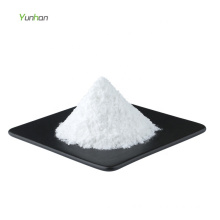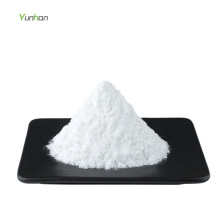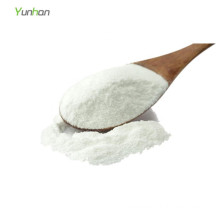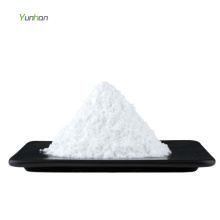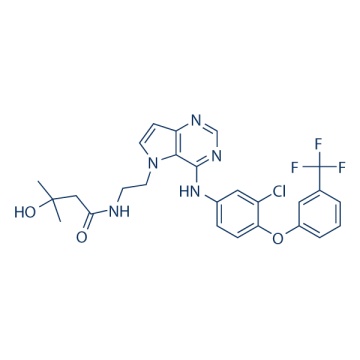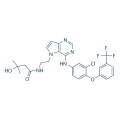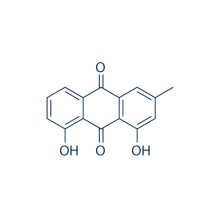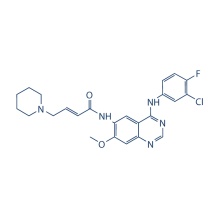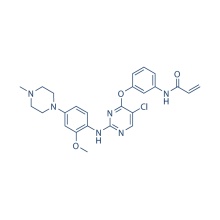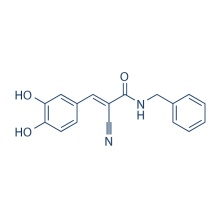TAK-285 871026-44-7
Product Description
.cp_wz table {border-top: 1px solid #ccc;border-left:1px solid #ccc; } .cp_wz table td{border-right: 1px solid #ccc; border-bottom: 1px solid #ccc; padding: 5px 0px 0px 5px;} .cp_wz table th {border-right: 1px solid #ccc;border-bottom: 1px solid #ccc; padding: 5px 0px 0px 5px;}
Molecular Weight:
547.96 TAK-285 is a novel dual HER2 and EGFR(HER1) inhibitor with IC50 of 17 nM and 23 nM, >10-fold selectivity for HER1/2 than HER4, less potent to MEK1/5, c-Met, Aurora B, Lck, CSK etc. Phase 1.
Biological Activity
Among the 34 kinases tested, TAK-285 only significantly inhibits HER4
with IC50 of 260 nM, slightly inhibits MEK1, MEK5, c-Met, Aurora B, Lck,
CSK, and Lyn B with IC50 of 1.1 μM, 5.7 μM, 4.2 μM, 1.7 μM, 2.4 μM, 4.7
μM, and 5.2 μM, respectively, and displays no activity against other
kinases with IC50 of >10 μM. TAK-285 shows significant growth
inhibitory activity against BT-474 cells (HER2-overexpressing human
breast cancer cell line) with GI50 of 17 nM.
Compared
with SYR127063 a Potent Inhibitor of HER2, TAK-285 displays similar in
vitro potency against HER2 and EGFR. Compared with the full cytoplasmic
domains of the wild-type Proteins, the mutations and shortened
boundaries used for structure determination of HER2-KD and EGFR-KD do
not significantly change the inhibitory activity (IC50) of TAK-285.
TAK-285 binds to the inactive conformation of EGFR, and shows a similar
binding mode with lapatinib in the active site.
The oral bioavailability of TAK-285 is 97.7% in rats and 72.2% in mice
at a dose of 50 mg/kg. Oral administration of TAK-285 at 100 mg/kg twice
daily for 14 days displays significant antitumor efficacy in the
HER2-overexpressing BT-474 tumor xenograft mouse model with
tumor/control (T/C) ratio of 29%, without affecting body weight.
Similar
to the BT-474 model, TAK-285 exhibits dose-dependent tumor growth
inhibition of 4-1ST (HER2-overexpressing human gastric cancer tumor)
xenografts in mice, with T/C of 44% and 11% at doses of 50 mg/kg and 100
mg/kg, twice daily, respectively, without significant body weight loss
in mice.
Furthermore, TAK-285 treatment induces dose-dependent growth
inhibition of 4-1ST tumors in rats with T/C of 38% and 14% at doses of
6.25 mg/kg and 12.5 mg/kg, and, particularly noteworthy, tumor
regression with T/C of -12% and -16% at doses of 25 mg/kg and 50 mg/kg,
respectively. After oral administration of TAK-285, a
significant amount of TAK-285 is present in the brain of rats in
pharmacologically active, unbound form (approximately 20% of its free
plasma level), indicating that TAK-285 has a potential in the therapy of
CNS malignancies/metastases.
Protocol(Only for Reference)
Kinase Assay: [1]
Cell Assay: [1]
Animal Study: [1]
Conversion of different model animals based on BSA (Value based on data from FDA Draft Guidelines)
For example, to modify the dose of resveratrol used for a mouse (22.4 mg/kg) to a dose based on the BSA for a rat, multiply 22.4 mg/kg by the Km factor for a mouse and then divide by the Km factor for a rat. This calculation results in a rat equivalent dose for resveratrol of 11.2 mg/kg.
Chemical Information
Molarity Calculator
Dilution Calculator
Molecular Weight Calculator
Contact us if you need more details on 871026-44-7. We are ready to answer your questions on packaging, logistics, certification or any Other aspects about TAK-285 871026-44-7、871026-44-7 TAK-285. If these products fail to match your need, please contact us and we would like to provide relevant information.
Molecular Weight:
547.96 TAK-285 is a novel dual HER2 and EGFR(HER1) inhibitor with IC50 of 17 nM and 23 nM, >10-fold selectivity for HER1/2 than HER4, less potent to MEK1/5, c-Met, Aurora B, Lck, CSK etc. Phase 1.
Biological Activity
Among the 34 kinases tested, TAK-285 only significantly inhibits HER4
with IC50 of 260 nM, slightly inhibits MEK1, MEK5, c-Met, Aurora B, Lck,
CSK, and Lyn B with IC50 of 1.1 μM, 5.7 μM, 4.2 μM, 1.7 μM, 2.4 μM, 4.7
μM, and 5.2 μM, respectively, and displays no activity against other
kinases with IC50 of >10 μM. TAK-285 shows significant growth
inhibitory activity against BT-474 cells (HER2-overexpressing human
breast cancer cell line) with GI50 of 17 nM.
Compared
with SYR127063 a Potent Inhibitor of HER2, TAK-285 displays similar in
vitro potency against HER2 and EGFR. Compared with the full cytoplasmic
domains of the wild-type Proteins, the mutations and shortened
boundaries used for structure determination of HER2-KD and EGFR-KD do
not significantly change the inhibitory activity (IC50) of TAK-285.
TAK-285 binds to the inactive conformation of EGFR, and shows a similar
binding mode with lapatinib in the active site.
The oral bioavailability of TAK-285 is 97.7% in rats and 72.2% in mice
at a dose of 50 mg/kg. Oral administration of TAK-285 at 100 mg/kg twice
daily for 14 days displays significant antitumor efficacy in the
HER2-overexpressing BT-474 tumor xenograft mouse model with
tumor/control (T/C) ratio of 29%, without affecting body weight.
Similar
to the BT-474 model, TAK-285 exhibits dose-dependent tumor growth
inhibition of 4-1ST (HER2-overexpressing human gastric cancer tumor)
xenografts in mice, with T/C of 44% and 11% at doses of 50 mg/kg and 100
mg/kg, twice daily, respectively, without significant body weight loss
in mice.
Furthermore, TAK-285 treatment induces dose-dependent growth
inhibition of 4-1ST tumors in rats with T/C of 38% and 14% at doses of
6.25 mg/kg and 12.5 mg/kg, and, particularly noteworthy, tumor
regression with T/C of -12% and -16% at doses of 25 mg/kg and 50 mg/kg,
respectively. After oral administration of TAK-285, a
significant amount of TAK-285 is present in the brain of rats in
pharmacologically active, unbound form (approximately 20% of its free
plasma level), indicating that TAK-285 has a potential in the therapy of
CNS malignancies/metastases.
Protocol(Only for Reference)
Kinase Assay: [1]
| HER2 and EGFR kinase assay | The cytoplasmic domain (Amino Acids 676-1255) of human HER2 and the cytoplasmic domain (amino acids 669-1210) of human EGFR are expressed as N-terminal peptide (DYKDDDD)-tagged protein using a baculovirus expression system. The expressed HER2 kinase and EGFR kinase are purified by anti-FLAG M2 affinity gel. The EGFR and HER2 kinase assays are performed using radiolabeled [γ-32P]ATP in 96-well plates. The kinase reactions are performed in 50 mM Tris-HCl (pH 7.5), 5 mM MnCl2, 0.01% Tween 20, and 2 mM DTT containing 0.9 uCi of [γ-32P]ATP per reaction, 50 μM ATP, 5 ug/mL poly(Glu)-Tyr (4:1), and each purified cytoplasmic domain (0.25 μg/mL EGFR or HER2) in a total volume of 50 μL. To measure the IC50 value for enzyme inhibition, Increasing concentrations of TAK-285 are incubated with the enzyme for 5 minutes prior to the reaction at room temperature. The kinase reactions are initiated by adding ATP. After 10 minutes at room temperature, the reactions are stopped by the addition of 10% (final concentration) trichloroacetic acid. The γ-32P phosphorylated proteins are filtrated in a harvest plate with a cell harvester and washed free of [γ-32P]ATP with 3% phosphoric acid. The plates are dried followed by the addition of 25 μL of MicroScint0. The radioactivity is counted by a TopCount scintillation counter. IC50 values are calculated by nonlinear regression analysis of the percent inhibitions. |
|---|
Cell Assay: [1]
| Cell lines | BT-474 |
|---|---|
| Concentrations | Dissolved in DMSO, final concentrations ~10 μM |
| Incubation Time | 5 days |
| Method | The cells are treated continuously with various concentrations of TAK-285 for 5 days. The live cell numbers are counted with a particle analyzer. |
Animal Study: [1]
| Animal Models | Female BALB/c nu/nu mice bearing BT-474 or 4-1ST xenografts, and female nude rats (F344/N Jcl-rnu) bearing 4-1ST xenografts |
|---|---|
| Formulation | Suspended in 0.5% (w/v) methylcellulose solution |
| Dosages | ~100 mg/kg/day |
| Administration | Orally twice daily |
Conversion of different model animals based on BSA (Value based on data from FDA Draft Guidelines)
| Species | Baboon | Dog | Monkey | Rabbit | Guinea pig | Rat | Hamster | Mouse |
| Weight (kg) | 12 | 10 | 3 | 1.8 | 0.4 | 0.15 | 0.08 | 0.02 |
| Body Surface Area (m2) | 0.6 | 0.5 | 0.24 | 0.15 | 0.05 | 0.025 | 0.02 | 0.007 |
| Km factor | 20 | 20 | 12 | 12 | 8 | 6 | 5 | 3 |
| Animal A (mg/kg) = Animal B (mg/kg) multiplied by | Animal B Km |
| Animal A Km |
For example, to modify the dose of resveratrol used for a mouse (22.4 mg/kg) to a dose based on the BSA for a rat, multiply 22.4 mg/kg by the Km factor for a mouse and then divide by the Km factor for a rat. This calculation results in a rat equivalent dose for resveratrol of 11.2 mg/kg.
| Rat dose (mg/kg) = mouse dose (22.4 mg/kg) × | mouse Km(3) | = 11.2 mg/kg |
| rat Km(6) |
Chemical Information
| Molecular Weight (MW) | 547.96 |
|---|---|
| Formula | C26H25ClF3N5O3 |
| CAS No. | 871026-44-7 |
| Storage | 3 years -20℃Powder |
|---|---|
| 6 months-80℃in solvent (DMSO, water, etc.) | |
| Synonyms | |
| Solubility (25°C) * | In vitro | DMSO | 110 mg/mL (200.74 mM) |
|---|---|---|---|
| Water | <1 mg/mL ( | ||
| Ethanol | 54 mg/mL (98.54 mM) | ||
| * <1 mg/ml means slightly soluble or insoluble. * Please note that Selleck tests the solubility of all compounds in-house, and the actual solubility may differ slightly from published values. This is normal and is due to slight batch-to-batch variations. | |||
| Chemical Name | N-(2-(4-(3-chloro-4-(3-(trifluoromethyl)phenoxy)phenylamino)-5H-pyrrolo[3,2-d]pyrimidin-5-yl)ethyl)-3-hydroxy-3-methylbutanamide |
|---|
Molarity Calculator
Dilution Calculator
Molecular Weight Calculator
Contact us if you need more details on 871026-44-7. We are ready to answer your questions on packaging, logistics, certification or any Other aspects about TAK-285 871026-44-7、871026-44-7 TAK-285. If these products fail to match your need, please contact us and we would like to provide relevant information.
Product Categories : Protein Tyrosine Kinase > EGFR Inhibitor
Other Products
Hot Products
Astragaloside AChlortetracycline HCl 64-72-2Paclitaxel 33069-62-4Dexamethasone Acetate 1177-87-3Dinaciclib (SCH727965) 779353-01-4CHIR-124 405168-58-3Ro3280 1062243-51-9TAME 901-47-3CCG-1423 285986-88-110058-F4 403811-55-2Dabigatran (BIBR 953) 211914-51-1H 89 2HCl 130964-39-5T0901317 293754-55-9Aprepitant 170729-80-3Turofexorate Isopropyl (XL335) 629664-81-9BMS-378806 357263-13-9

